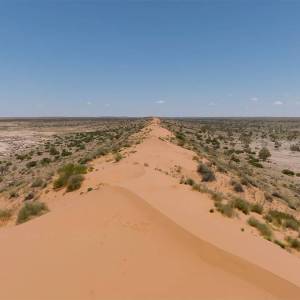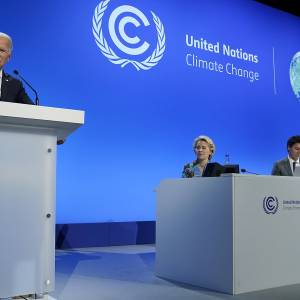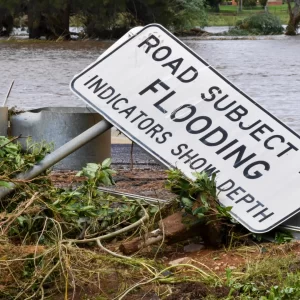
What happens if you’re uninsurable?
The term ‘uninsurables’ refers to an emerging population unable gain access to or afford adequate home and contents insurance. As climate change continues to alter the frequency and severity of natural disasters, average Australians will be exposed to the impacts of a property or business that is entirely uninsurable, potentially resulting in homelessness, forced migration and severe wealth inequality.
Key learnings
- Natural disasters have been consistently growing over the previous few decades, with extremities rising from 3.9 to 6.5 annually across a 30-year period, producing an evolving, newfound volatility for insurance provisors
- Recent years have demonstrated a step towards underinsurance, with half of Australians found to be inadequately and partly insured against natural disasters.
- These trends surrounding underinsurance are readily evolving into complete refusal or drastic price hikes from insurance companies, particularly in areas such as Northern Queensland which have experienced high climate volatility and where risks are difficult to accurately calculate.
- As property values in disaster prone areas deflate, Australia is expected to see heightened wealth disparity, inequality, and homelessness.
- A combination of large-scale infrastructure projects and stringent climate policies can be identified as key tools towards combating these rising tends, as current attempts have been small-scale and inconsistent.
Background: Australia’s climate context
Australia’s arid climate is particularly vulnerable to the effects of climate change, and this susceptibility paired with climate inaction has immensely impacted Australian homeowners and the insurance industry who have been dealing with escalating major losses, price inflation and soaring risk. As climate change remains unchecked, Australian cities will become progressively exposed to bushfires, cyclones, drought induced soil subsidence, heatwaves riverine flooding, and coastal inundation, with insurers increasingly shouldering the burden and, in some areas, already operating at a loss (Moss & Burkett, 2020).
Between 1990-2018 the average rate of natural disasters over a decade rose from 3.9 to 6.5 annually and are continuing to become increasingly severe. In recent years, insurers Have become gradually aware of heightened losses and volatility posed by climate disasters causing them to withdraw drastically rise insurance in disaster prone markets (Edwards, 2016). Climate scientists have reported that by 2100, 1 in 20 Australian houses will be completely refused insurance coverage; or annual premiums will be priced at or over 1% of the cost to reconstruct the property, becoming effectively unattainable and unaffordable (Ting et al., 2020).
In 2020 alone, the amalgamated events of black summer, Sunshine Coast & Canberra hailstorms, and the East Coast storms and floods, totalled to insurance losses of $5.3 billion, with only two out of six top insurers making a profit, and according to Marsh’s Global Insurance Market Index, the cost of basic home and contents insurance rose by 23% in Q1 2020 (Kurmelovs, 2021). Following Cyclone Debbie, North Queensland premiums jumped on average 2.7 percent (Hughes, 2020).
Previously following extreme disasters, resilience recovery grants and one-off payments have been made available to local governments, small businesses and affected residents under joint state and federal initiatives including the DRFA, DRA, NDRRA etc (Australian Government, 2020). Under the Queensland Reconstruction Authority, there is also funding available through the Resilience and Risk Reduction Fund. In the past, while funding has been awarded to install fire breaks, riverbank stabilisation, flood modelling and mapping and evacuation centre upgrades, implemented projects have been delivered on a small scale, with half of the resilience projects centred on awareness and communication (Australian Government, 2020).
With consistently rising premiums and accelerating Australian underinsurance it is clear that risks are not being effectively mitigated, and further investment into infrastructure projects, risk calculation and effective climate change related policy is necessary to deescalate and prevent issues.
Briefing
The term ‘uninsurables’ essentially refers to an emerging class of Australians who due to changing patterns and frequencies of climate extremities, will eventually be unable to insure homes and belongings from natural disasters. A property is effectively uninsurable when climate risks are so volatile that insurers refuse to offer coverage or, if the annual premium is priced at or above 1 percent of the cost to replace the property, becoming unaffordable for the average Australian (Ting et al., 2020). As climate change worsens, a relatively hands-on government approach to disaster mitigation and surging Australian underinsurance is increasingly unsustainable.
By 2100, it is expected that adequate disaster coverage will become unavailable or unaffordable for 718,000 houses, with three-quarters of affected areas in densely populated urban cities (Ting et al., 2020). During the 2019-20 Black Summer fires Suncorp reported that three postcodes in Victoria and twenty in NSW were barred from gaining insurance coverage at all, with premiums rising by up to 50% in the aftermath (O’Mallon, 2021).
A consistent trend towards a severely underinsured population, with half of all insured Australians having inadequate coverage in the event of disaster, a number which is rising year-to-year (Booth & Lucas., 2018). One of Australia’s top home insurers, Allianz, reported that in 95% of its customers in NSW opted to bypass flood insurance in 2021, with only 75% of black summer affected areas owning home and contents insurance (Donnellan & Hose, 2021).
As trends in un-insurability surge, the dilemma will evolve into an underlying social justice issue associated with plummeting property values in highly volatile areas, leading to excessive risk on primarily low-income households (LaCour-Little, 2020). As demand decreases and prices are inflated for low-risk postcodes, this issue will only escalate effects on Australia’s poorest citizens. In time as climate disasters escalate in severty and frequency and risks continue to rise, the could lead to entire cities becoming demolished and abandoned, owners unable to afford repairs and reinstate life possessions, resulting in ghost towns or uninhabitable postcodes (Steffen et al., 2014). Insurance affordability also poses a significant threat for farmers who are adversely affected by droughts, fires, hail and flooding, which destroy crops and affect Australia’s supply chain and access to fresh produce (Steffen et al., 2019).
As climate disasters continue to rise, there is increasing emphasis on how risk is calculated, and how identified risks can be mitigated to decrease volatility and ensure Australians are able to recover or circumvent damages to properties, businesses, or possessions (Bone, 2014). Central to mitigating some of this risk is government investment into increased infrastructure, residential and business planning, and the possibility of insurance relief schemes similar to international models (De Vet et al., 2019). Industry investment into better understanding and calculating climate and disaster risks with improved accuracy is also essential to lowering premiums.
References
Angelique, D., Hose, N. (2021). Like many Australians, Joe couldn’t afford to take out flood insurance. Now he’s paying the price. ABC News. Retrieved March 25, 2021 from https://www.abc.net.au/news/2021-03-25/dreamhome-ruined-by-floods-no-insurance-highpremiums/100029530
Australian Government. (2020). Natural Disaster Relief and Recovery Arrangements. Department of Home Affairs. Retrieved May 5, 2021 from https://www.disasterassist.gov.au/disasterarrangements/natural-disaster-relief-and-recoveryarrangements
Bone, D., Addressing the high cost of home and strata title insurance in North Queensland. Suncorp Group. Retrieved May 5, 2021 from https://treasury.gov.au/sites/default/ files/201903/C2014-023_Suncorp.pdf
Booth, K.I., Lucas, C. (2018). Half of Australians don’t have the home insurance for when disaster strikes. ABC News. Retrieved May 5, 2021 from https://www.abc.net.au/news/2018-11-20/half-of-australians-lacking-home-and-contentsinsurance/10513742
De Vet, E., Eriksen, C., Booth, K., French, S. (2019). An Unmitigated Disaster: Shifting from Response and Recovery to Mitigation for an Insurable Future. International Journal of Disaster Risk Science, 10 (1), 179-192. https://doi.org/10.1007/s13753-019-0214-0
Duncan, H. (2020). Household insurance premiums set to soar. Retrieved May 5, 2021 from https://reia.asn.au/wp-content/uploads/2020/01/14January-2020-Household-insurance-premiums-set-tosoar.pdf
Edwards, Ian. (2016). Insurance and climate change. CoastAdapt. Retrieved May 5, 2021 from https://coastadapt.com.au/sites/default/files/factsheets/T4I10_1_Insurance_and_climate_change.pdf
Hudson, D. (2017). An Overview of the Actuaries Climate Index. Actuaries Digital. Retrieved May 5, 2021 from https://www.actuaries.digital/2017/02/09/an-overview-of-the-actuaries-climate-index/
Kurmelovs, R. (2021). Fire and flood: ‘Whole areas of Australia will be uninsurable’. The Guardian. Retrieved April 24, 2021 from https://www.theguardian.com/australianews/2021/apr/02/fire-and-flood-whole-areas-of-australia-will-be-uninsurable
LaCour-Little, A. (2020). Introduction: Natural Disasters and the Housing Market. Journal of Housing Research, 29 (1), 1-2. https://doi.org/10.1080/10527001.2020.1836914
Moss, J., Burkett, D. (2020). Climate Transitions Series: Social Justice and the Future of Fire Insurance in Australia. UNSW. Retrieved May 5, 2021 from https://climatejustice.co/wp-content/uploads/2020/05/The-Future-of-Fire-Insurance-in-Australia-2.pdf
O’Mallon, F. (2020). Double-digit rise to premiums after fires. Insurance Advisory Service. Retrieved May 5, 2021 from https://www.insuranceadvisoryservice.com.au/blog/posts/2020/apr/double-digit-rise-to-premiums-after-fires/
Steffen, W., Hunter, J., Hughes, L. (2014). Counting the costs: climate change and coastal flooding. Climate Council. Retrieved April 24, 2021 from https://www.climatecouncil.org.au/uploads/56812f1261b168e02032126342619dad.pdf
Steffen, W., Mallon, K., Kompas, T., Dean, A., Rice, M. (2019). Compound costs: how climate change is damaging Australia’s economy. Climate Council. Retrieved May 5, 2021 from https://www.climatecouncil.org.au/wp-content/uploads/2019/05/costs-of-climate-change-report-v2.pdf
Ting, I., Scott, N., Palmer, A., Slezak, M. (2020). The rise of red zones of risk. ABC News. Retrieved May 5, 2021 from https://www.abc.net.au/news/2019-10-23/thesuburbs-facing-rising-insurance-costs-from-climaterisk/11624108?nw=0
Queensland Government. (2020). Queensland Resilience and Risk Reduction Fund (QRRRF) successful projects. Queensland Reconstruction Authority. Retrieved May 5, 2021 from https://www.qra.qld.gov.au/QRRRF/queenslandresilience-and-risk-reduction-fund-qrrrf- successfulprojects






